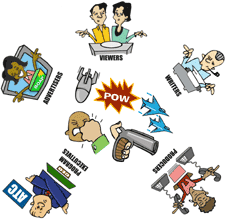Beyond Blame: Media Literacy as Violence Prevention
|
This article originally appeared in Issue# 62
|
Beyond the blame...beyond the debate...are human beings – children, young people and adults of all ages -- who are daily bombarded with violent images from the media and popular culture.
The parameters of this problem, as we've seen in the pages of this issue, are complex and interrelated. There are First Amendment concerns as well as public policies resulting from the deregulation of the media industry during the Reagan years. And as Walter Wink so eloquently writes in the first article, violence is the very stuff of our fundamental mythologies, including the myth of the American West.
While Hollywood may feed these myths, Hollywood did not start them. Nor can Washington legislate them under the rug.
Violence cannot be sanitized out of our culture even if, as I predict, and hope, gruesome and gratuitous violence becomes "politically incorrect" in popular entertainment. Over the decades,we've seen the media industry "self-censor" many creative ideas and images from the Amos 'n Andy stereotype of African Americans to the use of alcohol, cigarettes and even hard drugs. Excessive violence can be added to the list.
Media literacy must be a necessary component of any effective effort at violence prevention, for both individuals and society as a whole.
But there will still be violence in life, and in the media, because there is evil in the world and human nature has its shadow side. There is also grinding poverty and addiction and meaninglessness which creates a seedbed for violence as way for some to cope with injustice. Such violence will find its way into the news and into the storylines of both high art and popular culture.
After months of researching and working on this issue, it is clear to me that media literacy must be a necessary component of any effective effort at violence prevention, for both individuals and society as a whole.
I want to be clear that programs of media literacy do not excuse the storytellers of society from their share of responsibility for our cultural environment. But here are five ways I believe that media literacy can contribute to lessening the impact and incidence of violence in our world.
- Reduce exposure to media violence, particularly of the young, by educating parents and caretakers about the issue and helping them to develop and enforce age-appropriate viewing limits. How many times have you been in a violent R-rated movie and seen children there? Adults must come to realize that media violence today is different than when they were growing up. Parent organizations, churches and social workers need to get the message out that too much media violence can truly harm children. Programs of media literacy for parents can help.
- Change the impact of violent images that are seen -- by deconstructing the techniques used to stage violent scenes and decoding the various depictions of violence in different genres -- news, cartoons, drama, sports and music.
It
 is important for children to learn early on the difference between reality and fantasy and to know how costumes and camera angles and special effects can fool or mesmerize them. Media literacy activities need to be integrated into every learning environment -- school, church or temple, Scouts and clubs.
is important for children to learn early on the difference between reality and fantasy and to know how costumes and camera angles and special effects can fool or mesmerize them. Media literacy activities need to be integrated into every learning environment -- school, church or temple, Scouts and clubs. - Locate and explore alternatives to storytelling that highlights violence as the preferred solution to human conflict. Schools, libraries and families (and don't forget grandparents) need to have access to books and tapes that provide positive role models to help counterbalance the actions and attitudes of today's "superheros." Through media literacy classes, parents can also learn to transform undesirable images from popular culture into opportunities for positive modeling. One father, for example, let his child watch Teen-Age Mutant Ninja Turtles, but only if the child would imagine a fifth turtle named "Gandhi." Afterwards they had a great discussion on how "Ninja Gandhi" might get the Turtles out of trouble without resorting to violence!
- Uncover and challenge the cultural, economic and political supports for media violence - militarism, greed, competition, dominance, structural poverty-- as well as the personal ways we may each be contributing to the creation or perpetuation of a mediated culture of violence. We must not forget that the root of our cherished freedom of speech was not to protect creativity but to challenge the political and economic status quo. Media literacy empowers its participants to ask hard questions of themselves, of others and of society, by applying the principles of critical thinking to experiences that look like "mindless entertainment." Indeed the systemic analysis provided through media literacy can provide a learning curve to an informed and knowledgeable media activism.
- Break the cycle of blame and promote informed and rational public debate about these issues in schools, community and civic gatherings, religious groups and the media itself. The grim reality of our current situation demands that we ask two fundamental questions of ourselves as a society:
- What kind of culture do we want our children to grow up in?
- Can we continue to allow media makers to profit from products that are clearly contributing to a social condition that endangers public safety? An informed public is less vulnerable to extremist views or actions.



